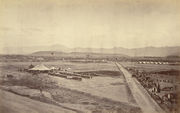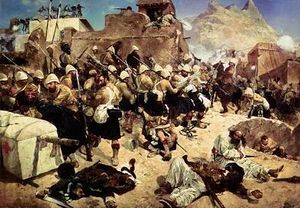Second Anglo-Afghan War
|
||||||||||||||||||||||||||||||||||||||||||||||||||||||||
|
||||||||||||||||||||||||||||||||||||||||||||||||||||||||
|
||||||||||||||||||||||||||||||||||||||||||||||||||||||||
The Second Anglo-Afghan War, in Afghanistan known as the Second War against the English, was a war between the United Kingdom and Afghanistan that lasted from 1878 to 1880.
Contents |
War
After tension between Russia and Britain in Europe ended with the June 1878 Congress of Berlin, Russia turned its attention to Central Asia. That same summer, Russia sent an uninvited diplomatic mission to Kabul. Sher Ali Khan, the Amir of Afghanistan, tried unsuccessfully to keep them out. Russian envoys arrived in Kabul on 22 July, 1878, and on 14 August, the British demanded that Sher Ali accept a British mission too.
The Amir not only refused to receive a British mission under Neville Bowles Chamberlain, but threatened to stop it if it were dispatched. Lord Lytton, the viceroy, ordered a diplomatic mission to set out for Kabul in September 1878 but the mission was turned back as it approached the eastern entrance of the Khyber Pass, triggering the Second Anglo-Afghan War. A British force of about 40,000 fighting men was distributed into military columns which penetrated Afghanistan at three different points. An alarmed Sher Ali attempted to appeal in person to the Russian Tsar for assistance, but unable to do so, he returned to Mazari Sharif, where he died on 21 February 1879.[3]

With British forces occupying much of the country, Sher Ali's son and successor, Mohammad Yaqub Khan, signed the Treaty of Gandamak in May 1879 to prevent a British invasion of the rest of the country. According to this agreement and in return for an annual subsidy and vague assurances of assistance in case of foreign aggression, Yaqub relinquished control of Afghan foreign affairs to Britain. British representatives were installed in Kabul and other locations, British control was extended to the Khyber and Michni passes, and Afghanistan ceded various frontier areas and Quetta to Britain. The British Army then withdrew.
However, on 3 September, 1879 an uprising in Kabul led to the slaughter of Sir Pierre Cavagnari, his guards, and staff - provoking the next phase of the Second Afghan War.
Major General Sir Frederick Roberts led the Kabul Field Force over the Shutargardan Pass into central Afghanistan, defeated the Afghan Army at Char Asiab on 6 October, 1879, and occupied Kabul. Ghazi Mohammad Jan Khan Wardak staged an uprising and attacked British forces near Kabul in the Siege of the Sherpur Cantonment in December 1879, but his defeat there resulted in the collapse of this rebellion. Yaqub Khan, suspected of complicity in the massacre of Cavagnari and his staff, was obliged to abdicate. The British considered a number of possible political settlements, including partitioning Afghanistan between multiple rulers or placing Yaqub's brother Ayub Khan on the throne, but ultimately decided to install his cousin Abdur Rahman Khan as emir instead.
Ayub Khan, who had been serving as governor of Herat, rose in revolt, defeated a British detachment at the Battle of Maiwand in July 1880 and besieged Kandahar. Roberts then led the main British force from Kabul and decisively defeated Ayub Khan in September at the Battle of Kandahar, bringing his rebellion to an end. Abdur Rahman had confirmed the Treaty of Gandamak, leaving the British in control of the territories ceded by Yaqub Khan and ensuring British control of Afghanistan's foreign policy in exchange for protection and a subsidy.
Abandoning the provocative policy of maintaining a British resident in Kabul, but having achieved all their other objectives, the British withdrew.
Timeline of battles

There were several decisive actions in the Second Anglo-Afghan War, from 1878 to 1880. Here are the battles and actions in chronological order. An asterisk (*) indicates a clasp was awarded for that particular battle with the Afghanistan Medal.
1878
- Battle of Ali Masjid* (Decisive British victory)
- Battle of Peiwar Kotal* (Decisive British victory)
1879
- Action at Takht-i-Pul
- Action at Matun
- Battle of Khushk-i-Nakud
- Battle of Fatehbad
- Battle of Kam Dakka
- Battle of Charasiab*
- Battle of Shajui
- Battle of Karez Mir
- Battle of Takht-i-Shah
- Battle of Asmai Heights (Afghan victory)
- Siege of Sherpur* (Decisive British victory)

1880
- Battle of Ahmed Khel* (British victory)
- Battle of Arzu
- Second Battle of Charasiab
- Battle of Maiwand (Afghan victory)
- Battle of Deh Koja
- Battle of Kandahar* (Decisive British victory)
1881
- Kandahar (and Afghanistan) Evacuation
Order of battle
- Peshawar Valley Field Force Lt Gen Sir Samuel Browne
- Cavalry Brigade Brig Gen C. J. S. Gough
- 10th Hussars (2 Sqdns)
- 11th Probyn's Lancers
- Guides Cavalry
- Royal Artillery
- First Infantry Brigade Brig Gen H. T. Macpherson
- 4th Battalion Rifle Brigade
- 20th Brownlow's Punjabis
- 4th Gurkha Rifles
- Second Infantry Brigade Brig Gen J. A. Tytler
- 1st Battalion Leicestershire Regiment
- Guides infantry
- 51st Sikhs
- Third Infantry Brigade Brig Gen F. Appleyard
- 81st North Lancashire Regiment
- 14th Sikhs
- 27th Punjabis
- Fourth Infantry Brigade Brig Gen W. Browne
- 51st King's Own Yorkshire Light Infantry
- 6th Jat Light Infantry
- 45th Sikhs
- Kurram Valley Field Force Major General Roberts
- Cavalry Brigade Brig Gen Hugh Gough
- 10th Hussars (1 sqdn)
- 12th Cavalry
- 25th Cavalry
Royal Artillery Col A. H. Lindsay
- First Infantry Brigade Brig Gen A. H. Cobbe
- 2nd Battalion, 8th Foot
- 23rd Pioneers
- 29th Punjabis
- 58th Vaughn's Rifles
- Second Infantry Brigade Brig Gen J. B. Thelwell
- 72nd Seaforth Highlanders
- 21st Punjabis
- 56th Rifles
- 5th Gurkha Rifles
- Kandahar Field Force
- First Division Lt Gen Donald Stewart
- Cavalry Brigade Brig Gen Walter Fane
- 15th Hussars
- 8th Cavalry
- 19th Fane's Lancers
Royal Artillery Brig Gen C. G. Arbuthnot
- First Infantry Brigade Brig Gen R. Barter
- 2nd Battalion King's Royal Rifles
- 15th Sikhs
- 25th Punjabis
- Second Infantry Brigade Brig Gen W. Hughes
- 59th East Lancashire Regiment
- 12th Kelat-i-Ghilzai Regiment
- 1st Gurkha Rifles
- 3rd Gurkha Rifles
- 2nd Division Maj Gen M A Biddulph
- Cavalry Brigade Brig Gen C. H. Palliser
- 21st Daly's Horse
- 22nd Sam Browne's Horse
- 35th Scinde Horse
Artillery Col Le Mesurier
- First Infantry Brigade Brig Gen R. Lacy
- 70th East Surrey Regiment
- 19th Punjabis
- 127th Baluchis
- Second Infantry Brigade Brig Gen Nuttall
- 26th Punjabis
- 32nd Pioneers
- 55th Coke's Rifles
- 129th Baluchis
Popular culture
Sherlock Holmes' friend (and story narrator) Dr. Watson briefly served in the Second Afghan War, as described in the first chapter of A Study in Scarlet. In subsequent books, occasional reference is made to the wound Watson suffered from a Jezail bullet.
M M Kaye sets the finale of her novel The Far Pavilions during the Second Afghan War, the hero, Ashton Pelham Martyn (Ashok) is sent to Kabul to assist as a British spy and his best friend is made head of the military mission that accompanies Sir Pierre Louis Cavagnari when he goes to Kabul as an advisor. The book ends with the fall of the Bala Hissar in Kabul, where the British force is living; the death of all the British force, British officers and Indian soldiers, after a bitter and hard fought battle (almost all of which is based on original sources); and the hero and his wife riding north into the Himalyas.
See also
- First Anglo-Afghan War
- Third Anglo-Afghan War
- European influence in Afghanistan
- Military history of Afghanistan
References
- ↑ Barry, Michael (1984). Le Royaume de l'Insolence. La Résistance Afghane du Grand Moghol à l'Invasion Soviétique. Paris: Flammarion. ISBN 2-08-211524-0.
- ↑ Rubin, Barnett R. (1995). The Fragmentation of Afghanistan. Yale University Press. p. 48. ISBN 0-300-091519-8. http://books.google.com/books?id=laG03iJF7t8C&printsec=frontcover&source=gbs_ge_summary_r&cad=0#v=onepage&q&f=false.
- ↑ Hanna, Henry Bathurst (1904). The Second Afghan War, 1878-79-80: Its Causes, Its Conduct and Its Consequences. 2. Archibald Constable & Co. pp. 150-155. http://books.google.com/books?id=GzQoAAAAYAAJ&printsec=frontcover&source=gbs_ge_summary_r&cad=0#v=onepage&q&f=false.
Bibliography
- Barthorp, Michael. 2002. Afghan Wars and the North-West Frontier 1839-1947 Cassell. London. ISBN 0-304-36294-8
- Wilkinson-Latham, Robert. 1977. North-West Frontier 1837-1947. Osprey Publishing. London. ISBN 0-85045-275-9
External links
- Second Anglo-Afghan War Chronology
- British Battles
- Online Afghan Calendar with Historical dates
- Frederick Roberts and the long road to Kandahar
- Anne S. K. Brown Military Collection, Brown University Library William Simpson's diary and album of sketches and watercolors covering the early part of the campaign, and done for the Illustrated London News
|
||||||||||||||||||||||||||

